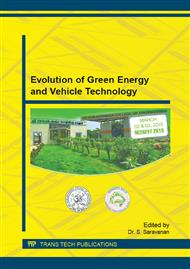p.79
p.87
p.93
p.102
p.107
p.112
p.118
p.124
p.130
Effective Fuel Consumption by Improving Cooling Water Flow Rate in IC Engine
Abstract:
The coolant (water) pump assumes an important role of cooling system in IC engines. With upgrading of the engine power by turbocharging and turbo inter cooling, the water pump capacity needs to be increased corresponding to the power. This capacity enhancement has to be achieved without calling for a major change in the existing water pump, envelop and related fitment details. This requires a clear understanding of centrifugal pump for its performance parameter. One such engine is upgraded by turbocharging from 195PS to 240PS @2200 rpm. Improving water pump flow by changing the impeller dimensions, impeller casing, increase the suction, delivery pipe diameter had been done. Validation of the water pump in its actual engine installation was taken up as a part of the research work. Flow rate comparison of the new pump with the existing pump was made and the results were analyzed. The new water pump gives better flow rates for the engine speeds up to1800 rpm, beyond which the flow rate is slightly lesser than the existing pump.
Info:
Periodical:
Pages:
112-117
Citation:
Online since:
November 2015
Authors:
Keywords:
Price:
Сopyright:
© 2015 Trans Tech Publications Ltd. All Rights Reserved
Share:
Citation:


